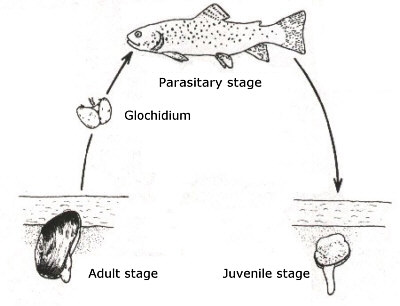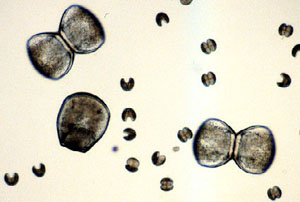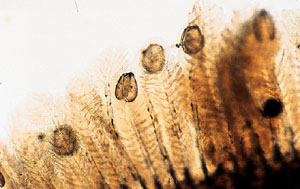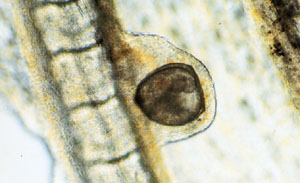Development of Fresh Water Mussels
 After
fertilisation of their eggs, which mostly happens inside the female's body, mussels develop
over several larval stages to form the juvenile mussel. While the mussel larvae do not
resemble
the adult animal, the juvenile mussels can easily be recognized as mussels. The various larval stages
each come into existence by a metamorphosis from the preceding stage.
After
fertilisation of their eggs, which mostly happens inside the female's body, mussels develop
over several larval stages to form the juvenile mussel. While the mussel larvae do not
resemble
the adult animal, the juvenile mussels can easily be recognized as mussels. The various larval stages
each come into existence by a metamorphosis from the preceding stage.
Sea living mussel species develop over the typical mollusc larval stages, the trochophora and the veliger
larva. The larvae drift with the plankton and that way are distributed by the sea currents. The
Unionoidea, large fresh water mussels, develop over a larval stage
that is different from those of sea-living mussels.

Different Glochidia
|
|
| |
|

Glochidia in their host fish's gills. Pictures:
M.C. Barnhart.
|
|
The glochidium is a parasitic larval form, that
develops from the fertilised egg. The fertilisation usually takes place in the female's gills,
that among some mussel species may even be transformed into breeding chambers. By the exhalant
siphon the glochidia leave the mother's body and sink to the ground. Glochidia have an average
size of between 0.1 - 0.4 mm. The already have two shell halves, that can be closed with a
closing muscle.
Ventilated afloat by a fish swimming past,
the glochidia are able to reach its gill filaments. Different mussel groups' glochidia have
a different construction. While pond mussels' (Anodonta) glochidia are armed with hooks
that give a better hold in the host's filaments, river mussels' (Unio) glochidia have
no hooks.
The glochidia having clung to the host fish's gill filaments, they are grown over by the fish's
epithelial tissue. A capsule is built, the so called cysts. In the cyst the glochidia endure
a certain time feeding on the fish's body fluids. The duration of the cyst stage is different. For
example the glochidial stage of river mussels (Unio) spawning in early summer lasts 10
to 70 days. Pond mussels (Anodonta) on the other hand spawn in late summer and the glochidia
stay inside the host's body until spring.
It may happen that host fish carry very many glochidia, they not only feed but also distribute.
In fish cultivating plants a heavy glochidial infection may cause losses. Most large fresh water
mussels, however, have become that rare, that a large infection by their glochidia is rather
improbable.
The reason partly is that glochidia are very specific about their host fish. For
example the river pearl mussel (Margaritifera margaritifera) depends largely on the
brown trout (Salmo trutta fario). That fish only occurring in very clean and fast flowing
creeks and rivers, makes also the large mussels only to be found there, for example in the Bavarian
and Bohemian mountains.
The displacement of the brown trout by the imported American rainbow trout
(Oncorhynchus mykiss) apart from the growing water pollution is one of the main reasons for
the threatening extinction of the river pearl mussel.
Further Information:
 After
fertilisation of their eggs, which mostly happens inside the female's body, mussels develop
over several larval stages to form the juvenile mussel. While the mussel larvae do not
resemble
the adult animal, the juvenile mussels can easily be recognized as mussels. The various larval stages
each come into existence by a metamorphosis from the preceding stage.
After
fertilisation of their eggs, which mostly happens inside the female's body, mussels develop
over several larval stages to form the juvenile mussel. While the mussel larvae do not
resemble
the adult animal, the juvenile mussels can easily be recognized as mussels. The various larval stages
each come into existence by a metamorphosis from the preceding stage.

